#editor stuff
Explore tagged Tumblr posts
Text
Can someone legitimately help me break down how the hundred thousand Crystals’ worth of rewards is being spread through this update? Because I’m not seeing it, and the developers have remained eerily silent on how they worded this.

4 notes
·
View notes
Text










Never posted this one here, so it's now time.
My comic for the 2017 MegOp Zine, "Equinox". It was a project I really loved and I'm humbled that so many great artists participated on it. Forever grateful! The edition turned our pretty neat and I still cherish it on my bookshelf :>
#megop#tfp#transfomers#transformers prime#megatron#optimus prime#orion pax#megatronus#tfp optimus prime#tfp megatron#comic#my stuff#ESTO EXISTE POR LA CANCION DE ODIAME DE BUNBURY JAJAJA#ódiame sin medida ni clemencia#que tan sólo se odia lo querido#entinté ésto a mano no mmn estuvo chido#quiero volver a entintar a mano pero ahorita ando en crisis#crisis mental#por cierto que no mmn tengo ésto en mi portafolio profesional o sea así de mucho soy pro megop carajo#y sí tengo empleo jjajaja#igual y tendría más si no lo tuviera ahí? no lo sé pero pues#es loco pensar que editores pro y gente que considero mentores de la industria editorial aquí en Mx lo hayan visto jajajajaja QUE PERRO OSO
4K notes
·
View notes
Text
I'd like to add something I've come across in my work: using headings, document outlines, and Styles.
(Disclaimer: This advice is mostly appropriate for indie authors and/or those working with freelance editors. Obviously, as OP said, it's crucial that you follow any publication guidelines set out!)
In Google Docs and MS Word, you have the options to make chapter titles into headings by applying a Style, which automatically creates a document outline. There's a Styles menu in both Word and GDocs. It is extremely helpful to an editor when chaptered works have an outline so we can jump between sections quickly to double-check consistency matters. Having proper chapter/part headings will also save you A Lot of time if you're formatting your book for publication yourself ��� especially with generating a table of contents, which afaik all e-publishing platforms require ebooks to have.
An editor's job, especially in copy-editing, can include applying the correct Styles to a document and making sure these are consistent. Some companies and publications have specific Styles that they want you to use, which is when it can become the editor's job to apply them. Still, you're making the editor's job a lot easier if you do at least the chapter headings step yourself! Like OP said, an editor can help your book become its best version when they can focus on the words and not the formatting.
It's also helpful if you make sure Styles are applied where they should be – I.e., make sure that every block quote has the block quote style applied to it and isn't just a plain paragraph. (Incidentally, publications will have guides for when to use a block quote and when to use an inline quote. Generally this is decided by the number of words. Make sure you've followed these guidelines when you're checking formatting!)
Outside of headings, Styles are also used for elements like block quotes, bullet lists, first paragraph, section breaks etc. They're a great shortcut so you don't have to manually repeat the formatting for these elements every time you use them, too, and make checking and updating the formatting of your book so much easier. If you modify a Style, it applies those changes to every instance of the Style across the whole manuscript, which is a lot more efficient than going through and changing the formatting of every single chapter heading or block quote individually.
How to Format Your Finished Manuscript
as written by a perpetually flabbergasted editor
Congratulations, you’ve finished a manuscript! That monumental achievement alone deserves a reward. Please get yourself something delicious—don’t worry, I can wait.
Back? Awesome, because it’s time to talk about an important step of the prepublishing and/or pre-editing process, and that is how to format your manuscript.
When you’re writing your manuscript, it’s likely you have a unique setup. Fancy fonts, different text and document background colors, your preferred way of formatting the document—all elements work together to create a comfortable writing space where you can be your most creative.
As both a writer and editor, I have no problems with writers going wild with their documents’ technical aspects while they’re drafting—I do exactly the same thing when drafting. But when it comes time to share your project with other people—especially professionals in the publishing world—your snazzy setup is no longer going to be a benefit. I could share horror stories relating to document setup, from thousands of spaces used instead of the tab key to wacky file conversion issues.
Please don’t make your editor’s job any harder than it needs to be. Fancy formatting looks great, but it can be a nightmare to undo and wastes time that your editor could otherwise spend polishing the words themselves rather than what’s around them. It’s also significantly easier to work with a document that adheres to a standard format because it’s easier to catch mistakes that way—the editor isn’t distracted trying to wrangle extra spaces and text appearing in other languages.
Most publishing houses have what are called submission guidelines. Read them. Follow them. There’s little chance your manuscript is exempt from the rules, and believe me when I say authors who flaunt the guidelines don’t win the respect of the people who are working on their manuscripts.
If the publisher/editing service you’re submitting to doesn’t have obvious guidelines, first ask about them. They might have preferences. If not, as follows are some basic standard practices in North American publishing.
First off, if you can’t bear to give up your fancy writing setup, create a new copy of your document specifically for editing/submitting. Clearly label it as such. Make sure you implement any changes to this for-editing/submitting document, not just your fancy original.
Page and text setup:
Remove any document background images/page colors.
Change the entire document’s font to Times New Roman point 12. Make it black. Not dark gray, not dark brown—black.
Set the margins to one inch on all sides. This is Microsoft Word’s default document format, but not enough submitted manuscripts use it. Remember: layout for publishing comes after editing, not before. Editors are liable to completely change your document’s pretty formatting to industry standards anyway.
Set the document’s orientation to portrait, not landscape.
Center all section and chapter titles (e.g., Table of Contents, Chapter 1, Acknowledgements, About the Author, etc.).
Remove all double spaces from the file. Seriously. This is an incredibly easy step. Do not make your overworked, underpaid editor do this incredibly trivial and time-consuming task for you. Especially if you are using double spaces to indent or center content. If you, for some reason, are using the space bar to indent or center content, please stop what you are doing and follow these steps:
Use your word processor’s “center text” function. In programs like Word, this can be done by hitting Control + E. (Ctrl + L and Ctrl + R, respectively, align text left and right.) Do not justify your text unless the guidelines demand it.
Use the tab key to indent paragraphs.
But bear in mind that sometimes this can result in a “tab” character existing at the beginning of a paragraph. This is bad. Preferably, set the entire document to a 0.5-inch indent and delete all tab characters.
Seriously, though, you should be searching every document before you send it out or copy it to an online format for double spaces. Make this a good habit, and you’ll ensure you set yourself apart as a cut above the other writers out there.
Set the entire document’s line spacing to double.
Front matter, chapters, and back matter should be separated by page breaks, not by a series of blank lines.
If you really want to delight your editor or anyone else who needs to work on your manuscript, consider removing all leading and trailing spaces from the document (link embedded).
Style elements:
Run spell check. This sounds obvious, but trust me, I’ve received manuscripts riddled with obvious spelling errors. If you write with spell check off for one reason or another, turn it back on when you’re getting ready to send a document out. Make a full pass on the document, and pay attention to every instance of that red squiggle.
Make sure you’re spelling the names of your characters and places consistently. I’ve seen Matt become Mike in the next paragraph, and Donilo become Donillo. Editors’ trust in the author’s abilities to do anything with competence drop drastically when we find these kinds of careless errors.
Similarly, either use the American spellings or the British spellings. Be consistent.
Separate your scenes with fleuron breaks. Three centered asterisks (***) used without spaces is the most common method of creating a fleuron break and the one I recommend using, although sometimes three number signs/hashes (###) can be acceptable. Do not use fancy symbols or symbols created through special fonts. They will not carry through if your editor changes your entire document to Times New Roman.
Optional change: remove the indent from the first paragraph in a chapter or after a scene break.
Make a point of using punctuation consistently. If you’re going to use the oxford comma, use it every time. Use a single dash consistently. Punctuate dialogue properly.
Improperly punctuated dialogue is one of the most common errors editors fix. There are only a few basic rules, covered here (link embedded), so please make an effort to learn and use them.
Use paragraphs properly. New speaker = new paragraph. New subject = new paragraph.
Once again, if you really want to delight your editor, change all hyphens between number ranges to en dashes. 3-5 days will become 3–5 days.
Correctly title your document. The title isn’t somehow going to magically change from StupidProject.docx or afhuowjfoa;wijef.docx to TheHungerGames.docx between your submitting it and other people reading the title.
If possible, use the .docx file format.
I want to wrap this up by saying that yes, editors are here to catch the mistakes you’ve missed, and we invariably have obscure technical knowledge that most writers don’t know exists (in Greek, the question mark is represented by a semicolon), but it’s your job as the writer to put your best effort forward. Also bear in mind that not all editors get paid to handle formatting issues but are expected to resolve them anyway. Fixing these basic issues yourself or, better yet, not creating them at all will help both you and your editor(s) ensure the version of the book you put out is the best possible version.
2K notes
·
View notes
Text
happy one year anniversary to the most insane week in internet history
#mp100#mob psycho 100#reigen arataka#vid#EDITORS NOTE: sexymanotd deleted their twitter account which made finding stuff for this. very difficult.#i was unfortunately unable to include the BLOODSHED in the replies of the ingo poll and could only allude to it#i will never forget standing outside my calc class listening to people talk about how sad it was the queen died#while scrolling past WALLS of sans and reigen getting to third base on her grave
8K notes
·
View notes
Text


Skyrim Scenery 45/∞
#THESE GIFS WERE SO CURSED! BROKE MY EDITOR TIMELINE AND SEVERAL FILTERS DISAPPEARED! anyway pink skyrim yay#skyrim#tes#tesblr#skyrimedit#gamingscenery#gamingedit#tesedit#tesvedit#skyrim gifs#skyrim scenery#aaphra's stuff
433 notes
·
View notes
Text
Usopp no love song!
#one piece#art#fanart#digital art#sanji#black leg sanji#usopp#god usopp#sanuso#usosan#EXPLOSION SFX FROM ME#GOD i originally planned it to reach the finger waggling but the demons wanted MORE#twas fun messing with the editor this is defnitely a new experience#this means more sanuso shitposts hopefully i have a few ideas#i post more on my twitter under the same name tumblr is for my polished stuff
340 notes
·
View notes
Text

sorry just losing my shit over this deleted dialogue from 14x20
#sometimes I just want to have a long sit down with the directors/editors and ask them why they chose to remove stuff like this#in favor of say a yogurt fight#things that drive me insane about the tv show supernatural#spn 14x20#sam winchester#supernatural
685 notes
·
View notes
Text

"I'm the dog they put with cheetahs to keep them from going crazy in captivity" x "I'm the cheetah that is threatening to go crazy" 4 ever
(I make a webcomic about them)
#GODDDDDDDDDDD I love them#theyre so.....#I just.#good. theyre good#I need the comic to come back NOW...#no I dont. I havent finished enough yet#I've finished 7 episodes so I gotta make 3 more minimum but 8 more ideally. which is. a big gap..#anyways I got up early to draw this cause I couldnt sleep#and someone shared it in a server I'm in and I was like. oh I have to#but now I'm super tired and I can sleep#so good night. enjoy my beautuful art of my beautiful vampires#'good ngiht' it is 10 30 am.#sleep. she betrays me yet again.#anyways working on coming back working on kickstarter stuff working on book 4#working on commissions working on my patreon...#work work work work#trying to be forgiving of myself LOL working like 50-70 hours a week and still feeling like its not enough#imagine if I WASNT on meds rn. I'm focusing better and there's still just way too much sheesh#super need some support but also I'm chillin#I was assigned an editor and she has not given me a single note#so I'm like uhhh. rlly feeling aimless and lonely#I'm doing very good work its some of my best stuff#but...#yeah. idk. just a lot HAHAHA#but I got like 45 mins to do a quick drawing#for my mental health...#time and time again#adam and steve#ttawebcomic#adam
166 notes
·
View notes
Text

Wondering which readers will choose the smut option and risk an HR complaint on their first day of work LOL (for the editor route).
433 notes
·
View notes
Text


September 18, 2008
#destieledit#deancasedit#spnedit#supernaturaledit#destiel#deancas#supernatural#deancas mine#spn mine#my edit#my typog#my stuff#it's been so long since i last posted something here that i had to check what tags i used lmaoo#and also the photo post editor is different agdsfgh
829 notes
·
View notes
Text

Found a cool color palette. Might finish it later. (Probably not.)
#star wars#star wars the clone wars#star wars rex#star wars the bad batch#Glitched half an hour on his face for no reason#just cause I couldn't figure a skin color#like I come from impressionism#you know this small art movement#where half of the Chinese artists I follow borrows their wonderful color palette#Color palettes who are perfect to draw noice anime boys#but (we can't lie) where everyone tend to draw only fair skinned characters#So I'm bugged trying to draw realistic people with that#would probably help if I forced myself to do studies ya know#instead of looking at gensh1n art#skill issue as people say#maybe is should draw on a bigger file too#like not draw face with realistic feature on a 300x300 px square XD#But again this drawing was me procrastinating on another one#I hate finishing illu#I just wanna plan/doodle and layout#for others#my jobs of heart are storyboard or color key artist#background paint or compositing hell no#clean animation? kill me#I had a burn out last time I touched a graph editor#too bad that's the most demanded and entry level jobs#v_v#tips for people who want to enter animation industry#don't be like me#finish stuff
238 notes
·
View notes
Text
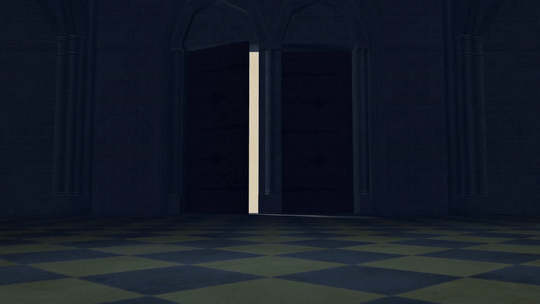
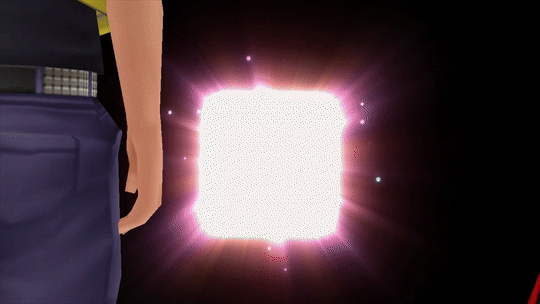
Do you remember before? We stood facing each other on opposite sides of that door. Now we stand side-by-side. Let's go home together this time.
#kingdom hearts#sora#riku#soriku#ddd#the hunchback of notre dame#gifs#ali's gifs#ali's kh gifs#i promise im alive ive just been dealing with mental health stuff (and spending less time on social media in general)#but i noticed this while editing ddd scenes for soriku comp 2.0#and now im MAD at myself for not seeing it sooner bc its NOT IN MY DISNEY COUPLES PARALLELS VIDEO >:((((((#anyway wild that both of these shots happen in the same game huh#and the heights line up (riku is on the same side as phoebus and hes taller than sora)#(just like phoebus is taller than esmeralda)#no hand holding tho cuz SENA is homophobic /s#alternate caption: lyrics from chikai#'light flows in from the opened door/i want to stay by your side forever after this too/theres been no other choice for me since long ago'#also hey using tag bundles through xkit switched this back to the old post editor and i can use pre text again 8)
313 notes
·
View notes
Text
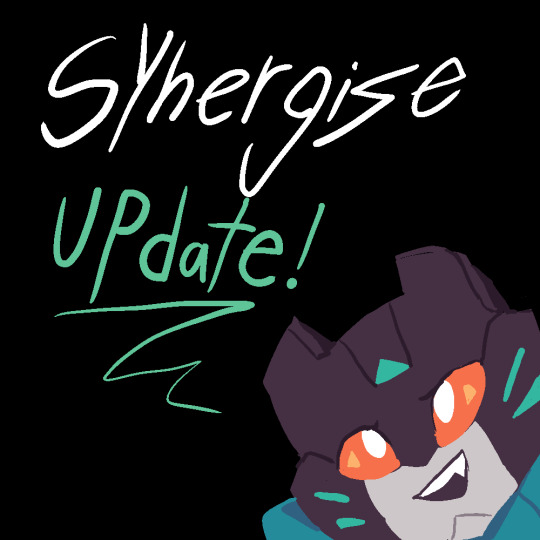
little update on the project and the comic
#transformers fan continuity#tfs#transformers synergize#text post#update#this project just me and my editor so gotta figure out lot stuff as i go#this is basically just a edited ramble#feel like im learning a lot from doing this project#idk if i should tag Thundercracker
201 notes
·
View notes
Text
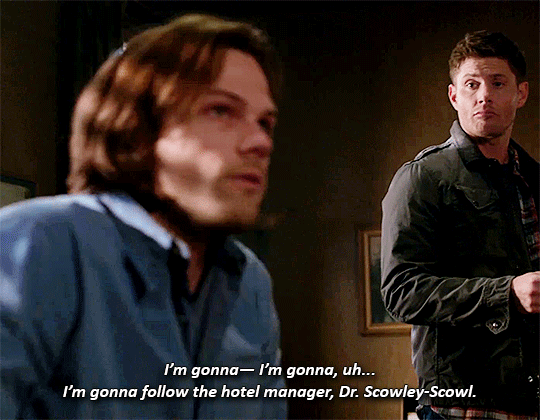





8.21 - The Great Escapist
#spn#supernatural#spn 8x21#sam winchester#dean winchester#winchester bros#spnedit#dailyspngifs#my stuff#myspn#canonspngifs#spncreatorsdaily#cowboycoven#scottstiles#tuserpris#tuserjord#useranny#deanncastiel#useralison#this was posted using the new editor bc tumblr decided to take the legacy editor away from me#and i want to tear my damn hair out#i just spent half an hour just trying to post this as a draft and idek if it's gonna work or look the way i want
743 notes
·
View notes
Text
What is going on with cutting posts?
You may have seen some posts floating around lately about the beta editor and trimming reblogs, and possibly found yourself extremely confused trying to figure out what this tangled web of editors, extensions, and add-ons even means. I’ve been on this site for years, and I still find the whole thing terribly confusing.
So this post is my effort to explain everything -- legacy vs beta, New XKit vs XKit Rewritten, editable reblogs vs trim reblogs -- everything. This also doubles as a tutorial for the various methods of cutting posts.
TL;DR
Tumblr is in the process of switching to a new post editor that some old users have opted into, while new users have been forced into it.
The old Editable Reblogs extension does not work with this new editor, requiring people to use a new extension called Trim Reblogs.
Trim Reblogs and Editable Reblogs are not compatible. If your partner uses Editable Reblogs, you cannot cut their posts properly using Trim Reblogs (unless you’re willing to do some tedious and frankly unreasonable workarounds).
The only way for everyone in the RPC to cut their posts properly and efficiently is if everyone moves to the new system and uses Trim Reblogs. Clinging to the old system with Editable Reblogs is actively creating issues for the people using the new system -- some of whom do not have a choice.
Cutting Posts
Cutting posts is the act of removing older replies on a thread when reblogging it. This goes by several other terms, including trimming replies/reblogs or any variation of that wording, but I will be referring to it as cutting posts to avoid confusion with the Trim Reblogs extension, which will be coming up a lot.
Typically, when cutting a post, you only keep your latest reply and the reply from your partner that immediately precedes it. This means that instead of a thread looking like this...

It would like this:
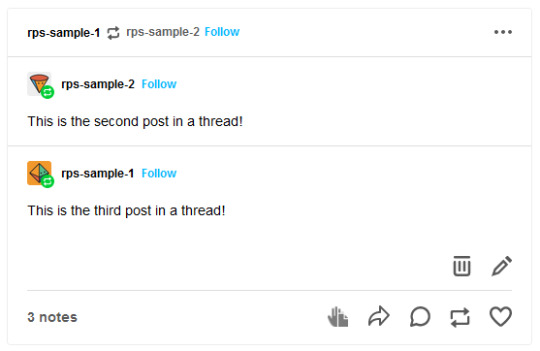
Or like this, depending on the method used:
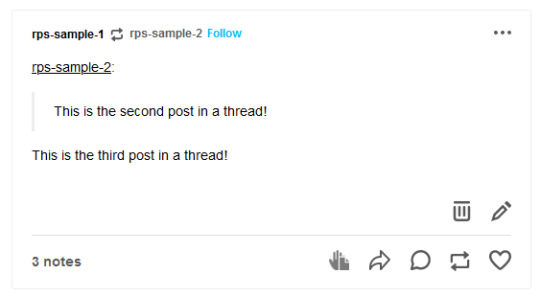
In either case, the first post is gone while the second and third post remain.
Cutting posts is done so that threads aren’t all extremely long on the dashboard. When there’s three short replies like this sample, it’s not that bad. But imagine a thread with twenty replies where each is several paragraphs long. That would require people to scroll and scroll and scroll to get past it. And since the same thread would be reblogged multiple times, your dash might become the same posts, over and over and over again, with only one new addition at the end each time.
Cutting posts is extremely common Tumblr RP etiquette. Many people won’t follow you if you don’t regularly cut replies, due to how irritating the alternative is.
Copy and Paste (Outdated)
Once upon a time, you used to be able to cut replies without any kind of extensions. Unfortunately, those days are gone.
That method worked as follows. You would go to reblog as usual...
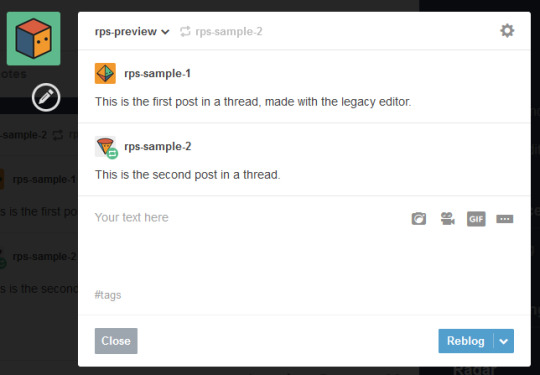
Copy and paste the last reply, putting it in a blockquote (or using any other formatting you like, really), then add your own reply underneath.
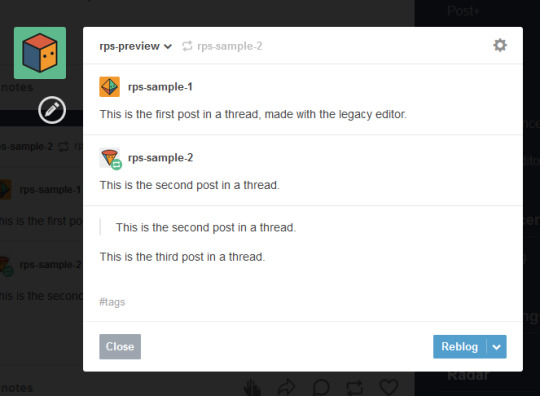
Then you can simply hover over the older replies and click the red X in order to remove them.

And this used to work. But now, the very first post in a thread cannot be deleted -- only later reblogs can. This means that the first post will always stay above the others, no matter how far along in the thread you are.
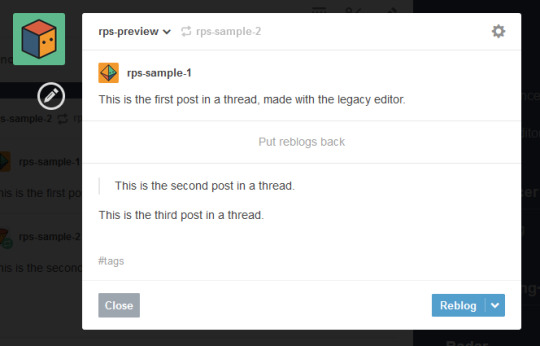
So since cutting posts can’t be done normally, we have to rely on browser extensions. This is where things get complicated. And also where I need to explain the different editors.
Legacy vs Beta Editor
Every time you make or reblog a post, you are using Tumblr’s post editor to do so. This is the area where you type up your post, add images, etc. Tumblr has been using the same editor for several years now, and it’s called the legacy editor.
However, Tumblr has been slowly rolling out a new text editor, called the beta editor. You may remember the beta editor when it was first rolled out a couple years ago as a buggy, unstable mess -- that’s not the case anymore, and it’s no more buggy than the current editor. For text posts, it’s functionally pretty similar, and even has a few features that some of you might want, such as easy colored text and the ability to make posts non-rebloggable. (Photo and other posts are fairly different, and I know gif makers have some pretty understandable reservations and complaints about it, but I won’t be covering that here.)
Older users have the option to toggle between the legacy and beta editors at will, while new users (starting around November/December 2022) are locked into the beta editor and cannot switch back to legacy.
To check which editor you have, go to make a new text post and look in the top right corner.
If you see either of these:


You are using the legacy editor, with the option to switch between the two.
If you see this:

You are using the beta editor, with the option to switch between the two.
If you don’t see anything at all, you are using the beta editor, and cannot switch.
While the text interface of the two editors isn’t terribly different for roleplay purposes, the methods by which you need to trim reblogs are entirely different. Each requires a different extension -- specifically, a different version of XKit.
XKit
XKit is a browser extension designed to add features and functionality to Tumblr. It includes many quality of life features such as a mutual checker, better tag tracking, queue improvements, ad blocking, more detailed timestamps, and so much more. (It was preceded by a similar extension called Missing E, if you’ve been here long enough to remember that.) And among all of these many features is the ability to cut replies.
The original XKit is no longer in use, having stopped updates in 2015 and being entirely unusable now. However, a few new versions of XKit have popped up throughout the years.
New XKit & Editable Reblogs
A different team created New XKit as a successor to the original, a similar extension designed to restore many of the same features.
New XKit’s feature to cut posts is called Editable Reblogs. It works by adding a pencil button to the left of the post when you reblog.

Clicking that button will break the post’s formatting -- actually changing it to how Tumblr posts used to be formatted -- but allow it to be edited however you wish.

So in this instance, I could simply select the first reply and delete it before adding my new reply underneath.
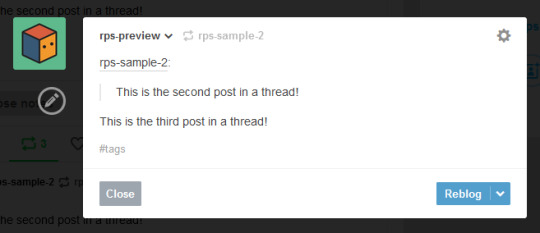
Editable Reblogs is only available if you use the legacy editor. It does not work with the beta editor and does not even appear as an option.
XKit Rewritten & Trim Reblogs
In 2020, Tumblr began to roll out its updated dashboard, which is now permanently in effect for all users. While the new interface looks very similar, the code was actually entirely redone, and behind the scenes functions very differently from the older dashboard. As a result, some of New XKit’s features no longer work as intended -- though a few still do, such as Editable Reblogs.
In response, the New XKit team decided to similarly start from scratch and created XKit Rewritten, another iteration of the add-on with similar features once more. However, not all New XKit features are available on XKit Rewritten, and vice versa. Many people are running both extensions simultaneously to take advantage of features on both.
XKit Rewritten’s feature to cut posts is called Trim Reblogs, and it works completely differently than Editable Reblogs. With this, you first need to save the thread to your drafts with your reply already written.

You’ll see a scissors icon appear along the bottom of the post. Clicking that will open the trimming options, letting you select which previous reblogs to delete.
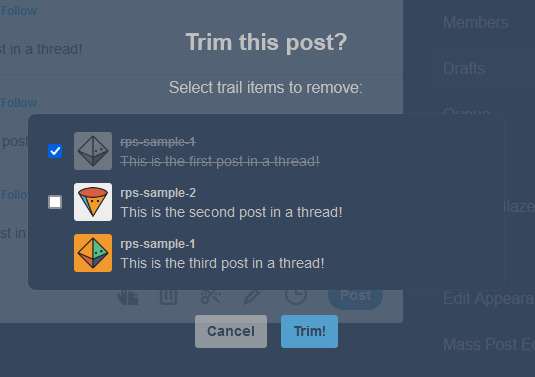
Clicking Trim will remove the selected reblogs.

You can then click post. You’ll note that this method preserves Tumblr’s formatting, as opposed to Editable Reblogs, which breaks it.
EDITED TO ADD: Apparently you don’t need to already have your reply written in your drafts anymore. You can save the post to your drafts without adding anything, use trim reblogs, then edit the post to add your reply. Either works fine.
This method does have two major issues, though. First, if the first post of a thread was created in the legacy editor, then the system gets really buggy and just doesn’t work.
This is what happened when I tried it out. Initially, it seemed to work as expected.
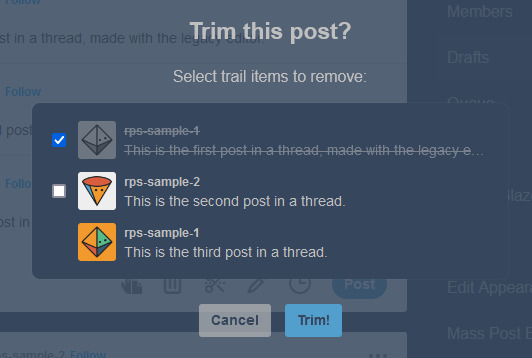

However, when I posted the reply, or simply refreshed my drafts, this happened.

Attempting to trim again simply caused this to repeat. There is no fix for this. This means that for this method to work, both you and your partners need to be using the beta editor.
EDITED TO ADD: You can fix this double posting by either using trim reblogs before adding your reply, or by adding your reply, using trim reblogs as intended, refreshing your drafts, editing the post, and clicking the red X to remove the first of the double postings. I have a better guide here.
The only other alternative is to move the thread to a fresh post when you reply, so that the new first post was made with the beta editor. Then you can cut future reblogs of the post using Trim Reblogs as normal.
However, the other major issue is that if your partner uses Editable Reblogs, you cannot use Trim Reblogs as intended. Let me show you why.
Say I want to reply to this post.

I’ll add my reply and save it to my drafts, as before.
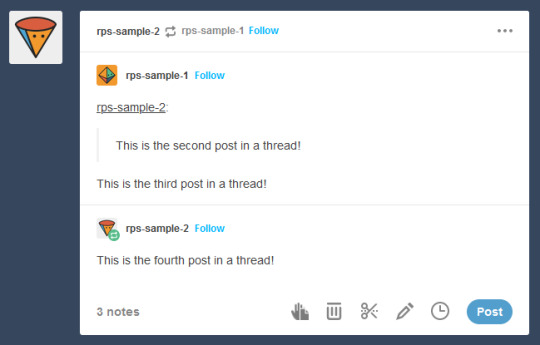
You may have spotted the issue already. The first and second replies are now “combined” so that Tumblr sees them as a single post. We want the post to be interpreted like this, so that I can remove the oldest reply while still keeping the one immediately prior to mine.
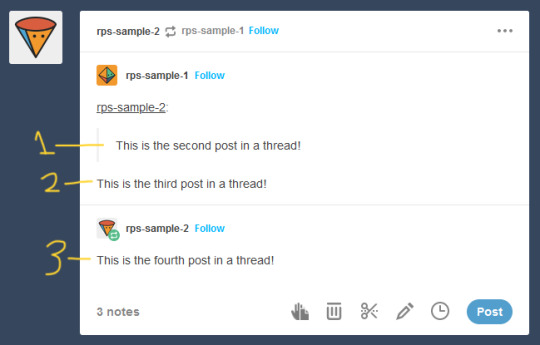
But Trim Reblogs can only see it like this.

When I go to trim reblogs, I can only remove the previous replies as an entire unit. I can’t remove just the oldest reply and keep the one immediately prior -- either it all stays or it all goes.


This is admittedly better than nothing. However, most people do want to keep their partner’s previous reply for reference, and just to have on their blog. This means a lot of people using Trim Reblogs simply don’t cut their partner’s posts at all.
You might be able to get around this issue by combining it with the outdated cut and paste method I described above. When saving to your drafts, paste your partner’s last reply above your own, using a blockquote or whatever formatting you like to separate the two.
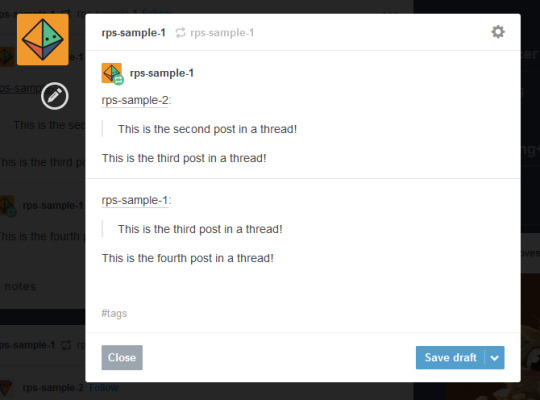
You can then use Trim Reblogs to remove the first post, leaving only your copy pasted reply. The formatting is broken, but it’s at least workable.

However, this will only work if the very first post of the thread was made with the beta editor -- since people using Editable Reblogs have to be using the legacy editor, you’re likely to still run into issues on a lot of posts. Which can again be solved by moving the thread to a fresh post made with the beta editor, but at this point we’re stacking so many issues on top of each other that I really can’t blame you if you just don’t want to bother with any of them.
All of this brings me to...
It’s time for the RPC to collectively switch to the new system
I’ve stuck to the legacy editor myself due to the issues described above -- using Trim Reblogs when everyone else still uses Editable Reblogs is an enormous pain that I don’t want to deal with. Even as I make this post advocating for people to switch, I’m dreading actually doing it, because I know that most of my partners still use the old system and I will have nothing but headaches.
But the thing is, everyone refusing to switch is what’s creating the headaches in the first place. If we all moved to the new system together, these issues would simply disappear, and we would all be able to effortlessly cut our posts using Trim Reblogs without ever having to worry about it again.
The RPC needs to collectively make the switch, for two reasons.
First, Tumblr is going to switch everyone to beta eventually. Refusing to switch now is really just delaying the inevitable -- it’s not a question of if you’re going to be forced into the new system, but when. By switching now, you can go ahead and get used to it and start giving feedback to both Tumblr and the XKit Rewritten team if you find anything buggy or broken.
Second, as I said above, new users are locked into beta, with no option to switch back to legacy. Trim Reblogs is their only option for cutting posts -- and as long as most of their partners are using Editable Reblogs instead, they cannot cut their posts properly. Their only option is to use a series of increasingly ridiculous workarounds that most people won’t understand. The fact that it took me 1500 words just to explain everything should tell you how confusing the whole thing is -- you can’t be that surprised when a lot of people, upon realizing that they can’t cut posts without a whole lot of tedium, decide to just not bother cutting them at all. The best way for everyone to be able to cut their posts properly and efficiently is for everyone to be on the same system.
Yes, the beta editor is different. It has some weird quirks. It will be a bit of a learning curve to get used to a new system of replying to threads. But this is a change that’s going to happen eventually, and is a change that needs to happen for a lot of people to able to cut their posts properly.
(It’s also worth noting that -- assuming you still have the option to switch -- you may be able to toggle between the two systems during the adjustment period. I haven’t been able to test this yet, but I see no reason it wouldn’t work. Use Trim Reblogs whenever possible, and especially for the partners that have already made the switch. But when you get to a reply that it just won’t work for, toggle back to the legacy editor and use Editable Reblogs just for that thread. It’s a bit annoying, but it could be the middle ground needed to help people start making the switch. And once the majority of the RPC is on the new system, then this won’t be an issue anymore.)
#rph#rpt#rpc#editable reblogs#trim reblogs#*my stuff#*my tutorials#this started as a tutorial for cutting posts and led into something else lmao#beta editor
2K notes
·
View notes
Text
Been watching through Link Click with my brother for Sibling Anime Night and, as this is my second watch, there are all these little details that are just driving me crazy. I have to remember not to say a darn thing because he doesn't know yet, but geez. They put some thought into this. They knew what they were doing.
Here are a few:
Qiao Ling telling Cheng Xiaoshi that Lu Guang is way more mature than him despite being the younger of the two.
Near the end of the first episode (in the sub), Lu Guang very insistently tells Cheng Xiaoshi to never ask about the future.
In the Noodle Lesbians episode, Cheng Xiaoshi telling Lu Guang, "Just because you don't see a glimmer of hope doesn't mean it's not hiding somewhere," and Lu Guang's expression fading into this soft smile as he chuckles, as if he's thinking, "It's just like you to say something like that."
In the basketball episode, how jealous Lu Guang sounds when Cheng Xiaoshi high-fives someone else.
When Cheng Xiaoshi runs out to start warning people about the earthquake, Lu Guang gritting his teeth and shouting, "You can't save them. They are already dead!" And then hurriedly lecturing Cheng Xiaoshi on how much of a fixed point death is no matter how much you might want to change it. "No matter how hard this is, you can't alter their fates!"
Lu Guang: "The future that we now know could completely disappear." (dub) "It could even cause the disappearance of the life we have now." (sub)
In the Aunt May arc, the three superheroes that our main three dress up as being the Star of Justice, Bringing Hope (Cheng Xiaoshi), Star of Courage, Conquering Fear (Lu Guang), and Star of Wisdom, Lighting the Way (sub)/Serving Knowledge (dub) (Qiao Ling). Gods, I could write an essay just on that.
I just... I just wanna grab some of these characters and shake them. Maybe slap them a few times. Why they gotta be like this?
#we're watching the sub but i watched the dub before#this one's definitely going on my “just watch the dub” list though#the sub is somehow gayer but it's also really poorly translated so it's distracting to read bc the english doesn't make sense#like no one says things like that in english please adapt it a bit more so it sounds natural#then again i'm an editor so i literally get paid to get annoyed by that stuff so ymmv#cheng xiaoshi#qiao ling#lu guang#link click#shiguang daili ren#sibling anime night#pancake thoughts
105 notes
·
View notes